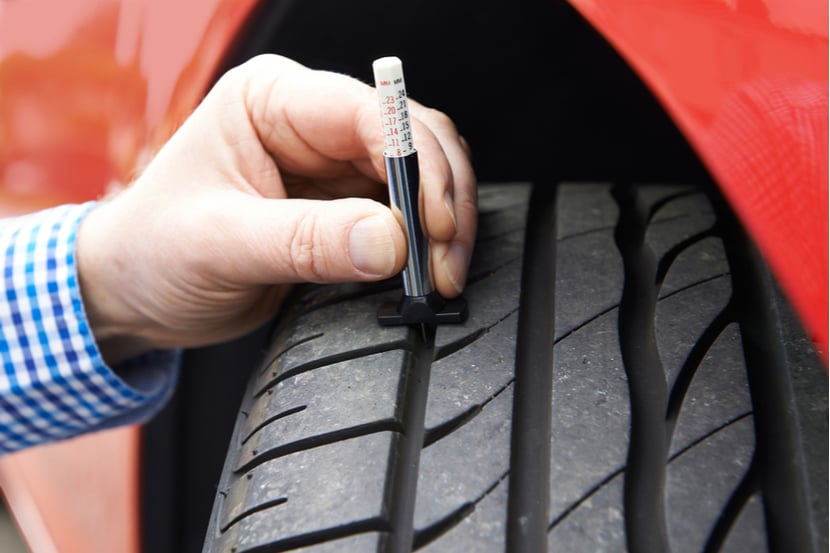5 Car Tyre Checks You Can Do Yourself
In order to prevent potential damage in the future, it’s important to check your car tyres and make sure they are in a suitable condition to drive. Here at Perrys, we have put together a list of checks you can do yourself without the help of a professional, Let’s look at them in more detail below.
1. Check Your Tyre Tread Depth
This is one of the most important checks to do when it comes to tyres, as safety is at stake and you could be fined up to £2,500 for worn tyres in addition to getting three penalty points. Moreover, if all tyres are worn and below the legal limit, you run the risk of losing your licence in addition to getting a £10,000 fine.
The legal tyre tread is 1.6mm across the central ¾ of your tyre. However, to safely hit the road, it’s recommended to have a minimum tread depth of 3mm or over as this will help dramatically when it comes to increasing stopping distances, where using this kind of tyre tread depth will increase your stopping distance up to 44%, improving your safety and that of your passengers. Less tread depth in your tyre translates into less water being shifted, consequently increasing the risk of aquaplaning and losing grip.
You can check your tyre tread depth using the 20p method described here.
Remember, if you have an accident on bald tyres, your insurance claim could be invalidated as you were driving on tyres below the legal limit (bald).
2. Check Your Overall Tyre Condition
It’s also crucial for you to regularly check the general condition of your tyres. Check for any stones and cracks on tyre treads and sidewalls. These could be caused by many reasons, from the age of your tyre(s), to hitting kerbs and potholes as well as having under-inflated tyres. Remember that if you spot some damage, get in touch with your local Perrys and we’ll be happy to assist you further.

3. Check Your Tyre Pressure
Your tyre pressure can usually be found in your vehicle manual, inside your car’s door sill, or even inside your fuel cap. It’s important to notice though that it varies between cars.
It’s recommended to check your tyre pressure on a monthly basis to be on the safe side or even more often if you usually carry out long journeys.
You can check your tyre pressure from the comfort of your home using a tyre air pump. You can buy it from many online retailers or supply stores if you don’t have one. Checking your car tyre pressure is not a complex process, follow these simple steps and you’ll be fine:
1. Wait until your vehicle has cooled down – 3 hours after it has been driven as the heat can affect the pressure reading –
2. Make sure your tyre pressure gauge is calibrated properly
3. Remove your valve cap, attach the valve adaptor to the tyre valve and lock it in place. Press down on the valve stem; the gauge will then display the current tyre pressure
4. Compare the reading to the recommended one in your vehicle handbook to see if it matches
5. Should you need to add more air to your tyres, plug the compressor into your vehicle’s charging point, switch your engine on and add your desired pressure.
Remember not to over-inflate your tyres as this could be dangerous and reduce your traction as only the centre of your care will make contact with the road if this is the case.
Also, please don’t leave your tyres under-inflated as this will wear them out more quickly and may cause cracks in the long term.
Lastly, remember, when you’re checking your tyre pressure, to check all your tyres as well as the spare tyre.

4. Keep Your Wheels Aligned and Balanced
Aligning your tyres will ensure your car handling is at its best, reducing wear and tear over time. Balancing your wheels is equally important as it ensures they make even contact on the road and no tyre becomes more worn than another.
Should you feel like your car is pulling either on the right or on the left, it may be an alignment issue. Contact us as soon as possible and we’ll be happy to book an appointment with one of our technicians.
5. Don’t Overload Your Car
Overloading your car will not only compromise its handling but also wear out your tyres due to the heat created by the additional weight your vehicle needs to carry. In order to avoid putting yourself and your passengers in danger, check your tyres to identify the maximum weight they can carry and stay within the limits when loading your vehicle.
We hope our article has helped you understand what tyre checks you can do yourself. However, should you require further assistance, don’t hesitate to contact your closest Perrys and we’ll be more than happy to help you.
Tags: *Car_Tyres *Car_Tyres_Checks *Car_Tyre_Tread_Depth *How_To *Tyre_Pressure


